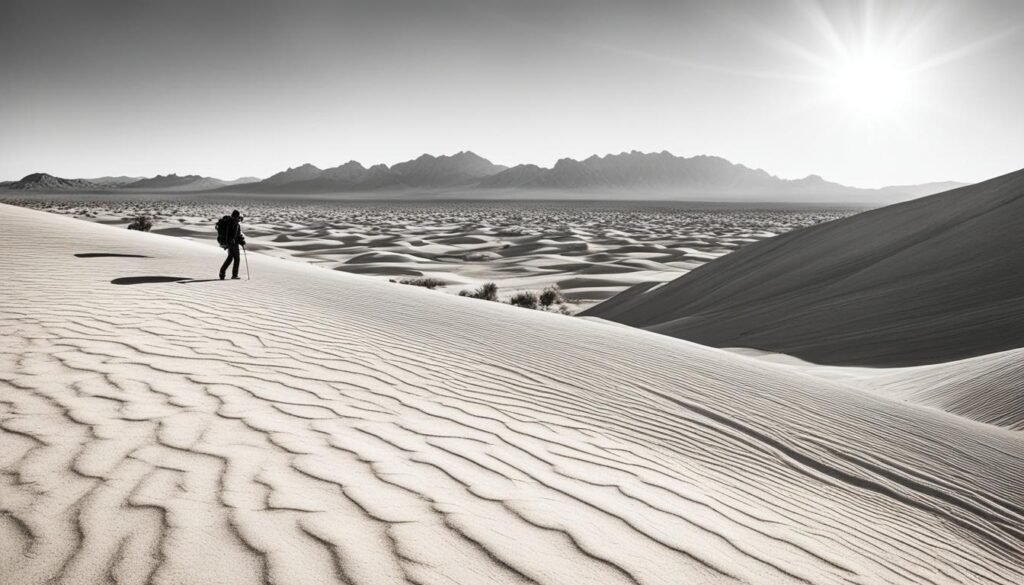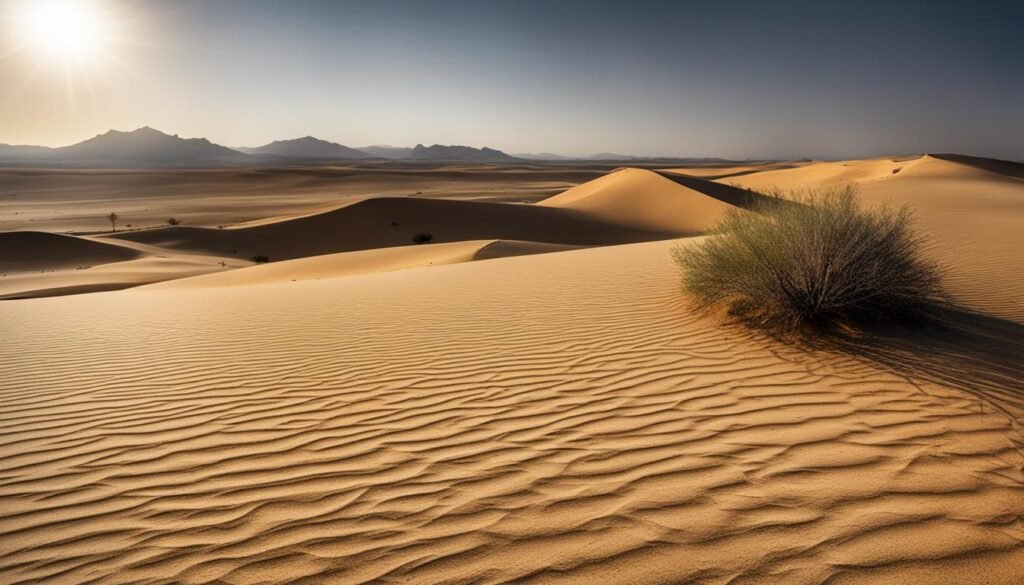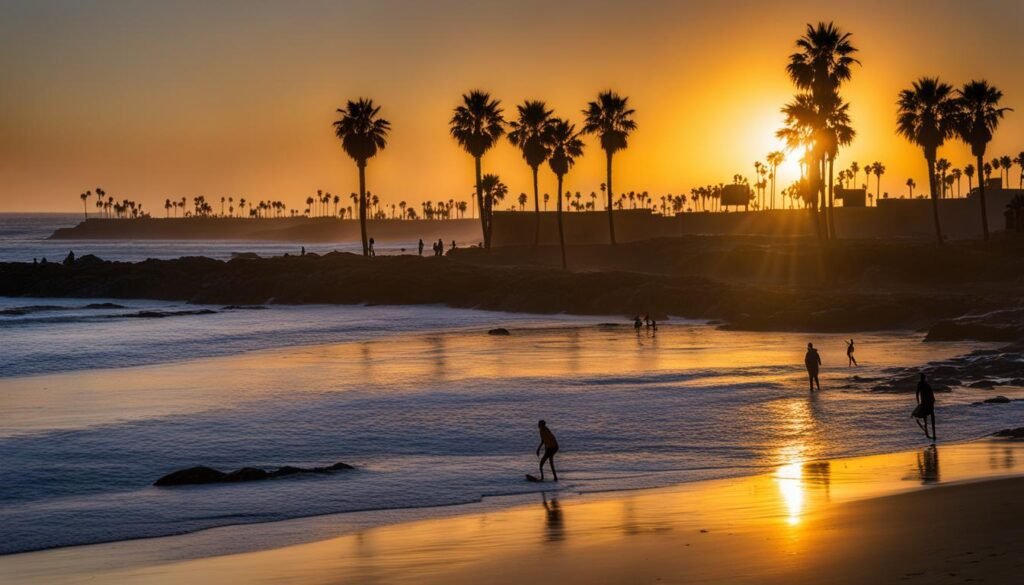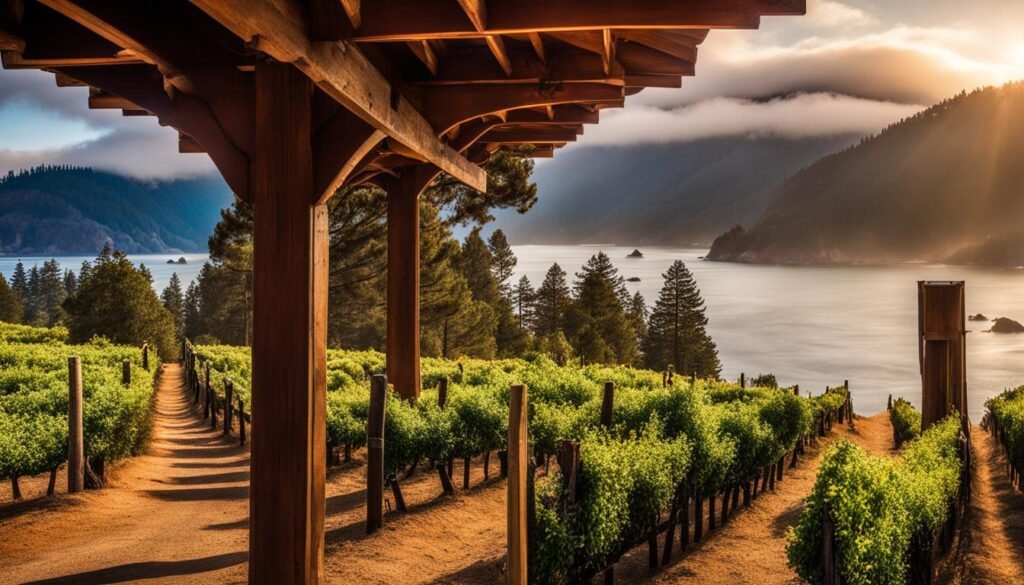Are you a nature enthusiast looking to embark on an exciting adventure? Look no further than the Mojave Desert. Located primarily in southeastern California and southwestern Nevada, with small portions extending into Arizona and Utah, the Mojave Desert offers a vast and mesmerizing landscape waiting to be explored.
The Mojave Desert is part of a larger North American Desert and is the smallest and driest of the deserts in the region. Named after the indigenous Mojave people, this desert showcases its unique beauty through its basin and range topography, with parallel mountain ranges and valleys that create stunning vistas.
Key Takeaways:
- The Mojave Desert is located primarily in California and Nevada, with parts extending into Arizona and Utah.
- It is the smallest and driest desert in the region.
- The Mojave Desert is characterized by its basin and range topography.
- It is home to iconic landmarks like Death Valley, the lowest elevation in North America.
- Exploring the Mojave Desert offers a unique and awe-inspiring experience.
Geography and Ecology of the Mojave Desert
The Mojave Desert, covering an area of approximately 47,000 square miles, is a fascinating and diverse ecosystem. Situated in southeastern California and southwestern Nevada, with parts extending into Arizona and Utah, the Mojave Desert is bordered by the majestic Sierra Nevada mountains to the west and the Sonoran Desert to the south.
Beyond its boundaries lie the Colorado Plateau and the Great Basin Desert to the north. Its unique geographical location contributes to its distinct characteristics and contributes to its exceptional biodiversity.
The Mojave Desert is known for its remarkable flora and fauna. With over 230 species of birds and 98 species of mammals, it offers a haven for wildlife enthusiasts. Among its notable inhabitants are the Mohave ground squirrel, Amargosa vole, and charismatic Joshua Tree, which is endemic to the region and adds to the desert’s mystique.
Relict forests atop the renowned New York and Clark Mountains, along with other fascinating plant species, contribute to the Mojave Desert’s ecological richness. This extraordinary landscape provides a vital habitat for numerous species and represents a unique and fragile natural heritage.
With its vast expanse and varied topography, the Mojave Desert is a captivating destination for nature enthusiasts and adventure seekers alike. The next section will delve into the climate and weather patterns experienced in this intriguing desert landscape.
Climate and Weather in the Mojave Desert
The Mojave Desert experiences a harsh desert climate with extreme temperatures throughout the year. Winter temperatures can drop below freezing, while summer temperatures can soar over 100 degrees Fahrenheit. The desert receives minimal rainfall, averaging between 2 to 6 inches annually, primarily in the form of rain.
The Mojave Desert is known for its hot and arid conditions, with occasional thunderstorms during the late summer months. These thunderstorms bring temporary relief from the scorching heat but are often accompanied by flash floods. It is important to be aware of weather conditions and take necessary precautions when exploring the desert.
A popular time to visit the Mojave Desert is during the cooler months of spring and fall when temperatures are more moderate. Springtime, in particular, offers milder temperatures and the chance to witness the desert’s vibrant wildflower blooms. It is advisable to check the weather forecast before your trip and pack appropriate clothing, sunscreen, and plenty of water to stay hydrated.
Key Points:
- The Mojave Desert has a desert climate with extreme temperatures year-round.
- Winter temperatures can fall below freezing, while summer temperatures can exceed 100 degrees Fahrenheit.
- The desert receives minimal rainfall, primarily in the form of rain.
- Occasional thunderstorms, mostly during late summer, may bring temporary relief but can also cause flash floods.
- The best time to visit the Mojave Desert is during the cooler months of spring and fall.
Landmarks and Attractions in the Mojave Desert
The Mojave Desert is a treasure trove of landmarks and attractions that offer awe-inspiring experiences for visitors. Whether you’re a nature enthusiast or an adventure seeker, the desert has something for everyone.
1. Death Valley National Park
Located within the Mojave Desert, Death Valley National Park is a must-visit destination. Known for its mesmerizing natural beauty, the park showcases unique geological formations, vast salt flats, and stunning sand dunes. It also boasts Badwater Basin, the lowest point in North America.
2. Mojave National Preserve
For those seeking solitude and wilderness, Mojave National Preserve is a true hidden gem. This national preserve offers diverse landscapes, ranging from desert plains to majestic Joshua Tree forests. Visitors can explore its vast wilderness, hike through picturesque canyons, and marvel at the mesmerizing Kelso Dunes.
3. Route 66 and Historic Landmarks
Travelers can step back in time by exploring the historic Route 66, which cuts through the Mojave Desert. This iconic highway presents an opportunity to discover ghost towns, vintage diners, and quirky roadside attractions. Be sure to visit the iconic Elmer’s Bottle Tree Ranch and the historic Roy’s Motel and Cafe.
4. Sand Dunes and Playa Lakes
The Mojave Desert is known for its stunning sand dunes, including the Mesquite Flat Sand Dunes and the Kelso Dunes. These expansive dunes offer breathtaking views and the perfect backdrop for outdoor photography.
Besides the dunes, the desert is dotted with mesmerizing playa lakes like the Ivanpah Playa and Silver Lake. These ephemeral lakes create a surreal landscape and attract unique wildlife, making them ideal spots for birdwatching and nature observation.
5. Joshua Tree National Park
Although primarily located in the Colorado Desert, Joshua Tree National Park extends into the Mojave Desert. This famous park is named after the unique Joshua Trees that dot its landscape. Visitors can hike through stunning rock formations, marvel at the iconic Joshua Trees, and stargaze under the pristine desert skies.
6. Outdoor Adventure and Recreation
From hiking and rock climbing to off-roading and camping, the Mojave Desert offers a plethora of outdoor activities. Explore the mesmerizing Mojave Preserve Wilderness, go off-roading in the Dumont Dunes, or embark on a thrilling rock climbing adventure in Joshua Tree National Park.


Whether you’re seeking natural wonders, historic sites, or adrenaline-pumping adventures, the Mojave Desert is brimming with awe-inspiring landmarks and attractions. Plan your visit and immerse yourself in the beauty of this unique desert landscape.
Economic and Historical Significance of the Mojave Desert
The Mojave Desert holds significant economic and historical value, making it an integral part of the region’s development. With its abundant natural resources and vast landscape, the desert has contributed to various industries, including mining and military training.
One of the desert’s notable economic contributions is mining. The Mojave Desert is home to diverse mineral deposits, such as silver, tungsten, iron, and gold. These resources have been extracted through mining operations, stimulating the local economy and providing employment opportunities for communities in the region.
In addition to mining, the vast and arid landscape of the Mojave Desert has made it an ideal location for military training. The desert’s expansive terrain offers realistic scenarios for military exercises and maneuvers. Its unique environmental conditions and remote location provide valuable training opportunities for military forces.
Beyond its economic significance, the Mojave Desert holds historical relevance. Iconic routes like Route 66 pass through the area, attracting tourists from around the world who seek to experience the nostalgia of the American West. The desert is also home to significant landmarks, such as Death Valley National Park, which further contribute to its historical and cultural heritage.
Mining in the Mojave Desert
Mining has been a crucial industry in the Mojave Desert, fueled by the presence of valuable mineral deposits. Companies and individuals have conducted mining operations, extracting resources such as silver, tungsten, iron, and gold. These minerals have been instrumental in the development of various industries, including manufacturing, electronics, and construction.
The mining industry in the Mojave Desert has brought economic prosperity to the local communities, providing jobs and driving economic growth. The extraction of minerals has contributed to the production of essential raw materials, supporting both national and international industries.
Military Training in the Mojave Desert
The vast expanse and challenging terrain of the Mojave Desert have made it an ideal location for military training. The arid conditions and diverse topography create realistic environments for military forces to conduct exercises, simulations, and tactical training.
The Mojave Desert’s remote and secluded nature allows military units to train with minimal disruption while preparing for real-world scenarios. The desert’s expansive landmass provides ample space for maneuvers, combat simulations, and the testing of equipment and technology.
- Realistic environmental conditions for training exercises
- Remote and secluded areas for secure military operations
- Expansive landmass for maneuvers and combat simulations
- Testing ground for equipment and technology
Tips for Exploring the Mojave Desert
When visiting and exploring the Mojave Desert, it is important to come prepared. The desert can be a harsh environment with extreme temperatures and limited amenities. To ensure a safe and enjoyable experience, follow these tips:
1. Carry Sufficient Water
The Mojave Desert is known for its aridity, and staying hydrated is crucial. Carry an ample supply of water to prevent dehydration. It is recommended to drink at least one gallon (3.8 liters) of water per day, especially during hot weather or when engaging in physical activities.
2. Protect Yourself from the Sun
The desert’s intense sun can be unforgiving. Apply sunscreen with a high SPF, and wear protective clothing, including hats, sunglasses, and lightweight, long-sleeved shirts. Don’t forget to protect your lips with lip balm containing SPF.
3. Plan Ahead and Research
Prior to your trip, plan your itinerary and research specific areas and attractions you wish to explore. The Mojave Desert offers a diverse range of experiences, from Joshua Tree forests to historic sites. By planning ahead, you can maximize your time and make the most of your visit.
4. Respect the Fragile Ecosystem
The Mojave Desert is a delicate ecosystem with unique flora and fauna. It is essential to respect and preserve its natural beauty. Follow park regulations and guidelines, stay on designated trails, and avoid disturbing wildlife or removing any natural resources. By being responsible visitors, we can help conserve this extraordinary landscape for future generations.
Exploring the Mojave Desert offers a chance to connect with nature and witness the mesmerizing beauty of this iconic desert landscape. By following these tips, your visit to one of America’s top desert travel destinations will be safe, enjoyable, and unforgettable.


Conservation and Future of the Mojave Desert
The Mojave Desert is a unique and fragile ecosystem that requires diligent conservation and protection. In recognition of its ecological significance, several national parks and preserves have been established to safeguard the desert’s diverse flora and fauna.
However, the Mojave Desert faces numerous challenges that threaten its future. Climate change poses a significant risk, with rising temperatures and altered precipitation patterns impacting the delicate balance of this arid landscape. Changes in habitat availability and fragmentation further disrupt the ecosystem, potentially leading to the loss of vital species.
Invasive species also pose a serious threat to the Mojave Desert. These non-native organisms can outcompete native species for resources, disrupt natural food chains, and cause irreparable harm to the delicate desert ecosystem.
It is imperative for ongoing conservation efforts to continue and expand, ensuring the long-term protection of the Mojave Desert. By employing sustainable practices, raising awareness about the importance of conservation, and implementing proactive measures, we can safeguard this precious desert for future generations.
Preserving the Mojave Desert not only sustains its unique natural beauty but also contributes to scientific research, educational opportunities, and the overall well-being of surrounding communities.
- Supporting local conservation organizations and initiatives can help protect the Mojave Desert’s future.
- By practicing responsible tourism and leaving no trace, visitors can minimize their impact on the delicate desert ecosystem.
- Continued research and monitoring are crucial for understanding the changing dynamics of the Mojave Desert’s ecology and implementing effective conservation strategies.
- Engaging in sustainable practices, such as water conservation and responsible land use, can mitigate the negative effects of climate change and habitat fragmentation.
By taking active steps to conserve the Mojave Desert, we can ensure its preservation and continued enjoyment for generations to come.
Conclusion
The Mojave Desert is a breathtaking destination that spans across California, Nevada, Arizona, and Utah. Its vast landscapes, teeming with diverse flora and fauna, and iconic landmarks make it an ideal choice for travelers seeking unique and unforgettable experiences. Whether you’re an adventurer looking to hike through the enchanting Joshua Tree forests, an explorer eager to dive into the region’s rich history, or simply a nature enthusiast yearning to immerse yourself in the desert’s natural beauty, the Mojave Desert will not disappoint.
This desert’s significance goes beyond its captivating appeal. It has played a vital role in the economy and historical development of the region. The Mojave Desert is home to valuable natural resources, with mining being a significant industry. Additionally, its expansive and arid landscape has been utilized for military training. As you journey through the Mojave Desert, you will also contribute to the ongoing conservation efforts aimed at safeguarding its fragile ecosystem for future generations to appreciate and cherish.
With its fascinating history, economic importance, and commitment to conservation, the Mojave Desert stands as one of America’s most captivating desert travel destinations. So, whether you’re wondering “where is the Mojave Desert?” or curious about what desert Las Vegas is in, a visit to this awe-inspiring region is a chance to discover the wonders of nature, embrace adventure, and create memories that will last a lifetime.
FAQ
Where is the Mojave Desert located?
The Mojave Desert is primarily located in southeastern California and southwestern Nevada, with small portions extending into Arizona and Utah.
What desert is Las Vegas in?
Las Vegas is located in the Mojave Desert.
How big is the Mojave Desert?
The Mojave Desert spans an area of approximately 47,000 square miles.
What are some attractions in the Mojave Desert?
The Mojave Desert is home to popular attractions such as Death Valley National Park, Mojave National Preserve, and historic sites like Route 66.
When is the best time to visit the Mojave Desert?
The best time to visit the Mojave Desert is during the cooler months of spring and fall.
What is the climate like in the Mojave Desert?
The Mojave Desert experiences a desert climate with extremes in temperatures throughout the year and very little precipitation.
What is the economic significance of the Mojave Desert?
The Mojave Desert has played a role in various industries, including mining, and has historical significance with iconic landmarks attracting tourists from around the world.
What should I keep in mind when exploring the Mojave Desert?
It is important to come prepared with plenty of water, sunscreen, and protective clothing. It is also crucial to respect the desert’s fragile ecosystem and follow any park regulations and guidelines.
What is being done to conserve the Mojave Desert?
Efforts have been made to preserve the Mojave Desert’s flora and fauna through the establishment of national parks and ongoing conservation initiatives. However, the desert still faces challenges such as climate change and invasive species.
Where can I find more information about the Mojave Desert?
For more information about the Mojave Desert, visit official websites of national parks, preserves, and tourism boards.









